Early on, Mastodon could have been written off as just another million-BPS metal act with over-distorted guitars and gruesome vocals. Luckily for us, things change and bands evolve. After their ridiculously heavy 2002 release, Remission, Mastadon recalibrated. Their evolution from speed metal to Sludge metal (an aggressive, dynamic branch of the metal universe, also referred to as “Southern Metal”) resulted in a more digestible slathering of sludgy guitars and climatically forceful vocals. 2004’s Leviathan was received by reviewers and music critics alike as a step in the right direction. While the release embraced their heavier sides, it unleashed a collection of harmonizing guitars, driving rhythmic patterns and an lyrical epic loosely based on Moby Dick and various other adventures at sea.
The boys from Atlanta knew they had something and they set out to prove it. Like Metallica with Master of Puppets, they honed their craft and exemplified their abilities on 2006’s Blood Mountain, an album widely considered their “epic.” It features melodic 12-string mastery by guitarist Brent Hinds on “Pendulous Skin” and equally soothing “Sleeping Giant,” which has been compared to Zeppelin’s “No Quarter.” These songs offer a cool contrast to the blistering, harmonized guitar attack with guitarist Bill Kelliher found on tracks like “Bladecatcher” and “This Mortal Soil.” With Blood Mountain they struck a near perfect equilibrium between hard and heavy and soulful and canorous.
Much like their new video for Crack the Skye’s “Divinations” Mastodon found themselves a top the mountain of previous successes and overwhelming expectations. With their latest release, they looked to break down their past accomplishments and forge something new and fresh; the band’s latest, Crack the Skye, draws influence from unlikely parties. The quartet of metal maniacs looked to their own favorites like the Melvins and Neurosis, but they also leaned on proggers like Pink Floyd, Gary Numan and even Yes to create their own prog-rock-metal rendition. Their ongoing progression and transition as a band and musicians climaxed when Crack the Skye entered the Billboard Top 200 at #11.
We recently caught up with Mastodon’s guitarists’ Brent Hinds and Bill Kelliher on their way to practice and talked about using producer Brendan O’Brien’s ultimate gear stash, hanging with Thin Lizzy’s Scott Gorham and their unlikely journey to acquiring some wicked Gibson Silverburst guitars.
What was it like working with renowned producer Brendan O’Brien [Mastodon’s previous three albums were produced by Matt Bayles]? And how the did different circumstances affect the recording process of Crack the Skye?
BK: It was funny, he told us before day one in the studio that he’d be really brutal on our music and that made us know our stuff pretty well prior to getting started. With Matt Bayles, we’d dial stuff in hundreds and hundreds of times, but with Brendan we’d just be prepared, rock a few takes and move onto the next thing. Another thing that helped while working with Brendan was that he’d just grab a guitar and just start jamming out a part of one of our songs and we’d know exactly what he meant and he’d be like, “Yeah, that part, lose it. Just take it out of the song.” I mean, he would never say anything sucked, but he’d really make sure we wanted or needed something in a particular song. Space and the ability for a track to breathe is something he really emphasized. He was just a no-bullshit kind of a guy. If you played a sour note or played something that didn’t sound right, he’d just tell you straight up that it wasn’t good enough and you’d have to make something else up or just move onto something else. We didn’t waste a lot of time.
BH: I loved every minute of it because Brendan seems to be cut from the same cloth as us. He’s much more of a Mastodon-type of a dude, which really helps bring out the best in us for this album. Matt is a great guy, but he’s just a little bit high-strung for our working environment and schedule. We had only worked with Matt so we thought that all producers were drill sergeants, but they’re not all that bad [laughs]. I think Brendan better suits us as far as attitude, demeanor and work ethic. Overall, I’ve never worked with someone with such ease as we did with Brendan. We love Matt and we’re still all great friends with him, but he’s just relentless with hundreds of re-takes for our vocals and guitars. Plus, Brendan works out of Southern Tracks [Atlanta, GA] and that allowed us to sleep in our own beds every night–that’s something worth noting for sure.
How have you guys prepared to present the new material to fans during the tour?
BH: We’re just going to play through the whole album. We have a keyboardist [Rich Morris] now so he’ll do the interludes, sampling and the keyboard parts on the album. We just did an in-store live performance at Criminal Records in Atlanta as a CD-release party show and we played the first five tracks off Crack the Skye. I went back and listened to the recording and it sounded amazing. We’ve been practicing for a few weeks now, just nailing down the album for a live setting and being able to play it all the way through; it doesn’t sound like the produced CD, it’s going to sound live, but either way it’s killer stuff.
BK: I mean, it’s great for bands that have all those crazy studio effects and sounds, but what happens when you can’t recreate that same sound on tour? The songs don’t even resemble the original track. While we know when we record we won’t be able to fully recreate the album verbatim, we’d like to try to nail it as close as possible during the live setting.
Bill, you’ve been a big advocate of the return of the album; how did you guys approach that mentality with Crack the Skye? Was this a conscious effort to produce something that forces a listener to go from start to finish?
BK: We always tried to do that with previous efforts, but I think we actually achieved it with this album. It’s like… get your life in order and take it off shuffle. I think we have always tried to get people to re-embrace the LP, when you’d sit down, put the record on, listen to the lyrics, check out the cover art, but I think we’re losing that feel of how LPs used to be. I remember putting on albums and just picking up a pad of paper and start drawing, or picking up my guitar and try playing along. Listening to those old LPs in that manner would just chill me out and put me in a creative state of mind. Now-a-days, everyone is too busy to sit down and actually enjoy music in that manner. We all have these gadgets to help us go-go-go, but it’s good to take an hour, put the record on and just enjoy the whole thing. I’d like to think that Crack the Skye is definitely an ode to traditional rock ‘n’ roll records like The Wall or Zeppelin II.
What was it like to hang out with Thin Lizzy’s Scott Gorham and play “Emerald” on some acoustic Gibsons?
For Brent, he’s a bigger Thin Lizzy fan than I am, and he was just beside himself like a little kid and couldn’t really think of what to say. We are going to try to get Scott to come on stage with us and play “Emerald” when we’re at the Knebworth Festival this summer.
Brent, that had to be particularly cool since you’ve noted Gorham as a heavy influence and had even played in a Thin Lizzy cover band.
BH: [laughs] Yeah those were the days; we even dressed the part too! As for Scott, he’s probably one of the coolest dudes I’ve ever met. He’s often labeled as an original guitarist of Thin Lizzy, even though he didn’t join the band until their fourth album, but that’s when they started that Thin Lizzy double-guitar attack we all know and love.
As for playing, it was kind of intimidating at first, because I’ve personally always looked up to him as a player, but he was such a cool dude it was like hanging out with one of our friends. By the end of the show [Rock Sound TV], we were talking gear, how he plays certain parts of Thin Lizzy songs and we just shot the shit with him about guitars and music. We both went in not knowing what to expect, but since then we’ve become friends and that’s the coolest part. Like Bill said, we’re hoping to get him on stage with us when we play the Knebworth Festival.
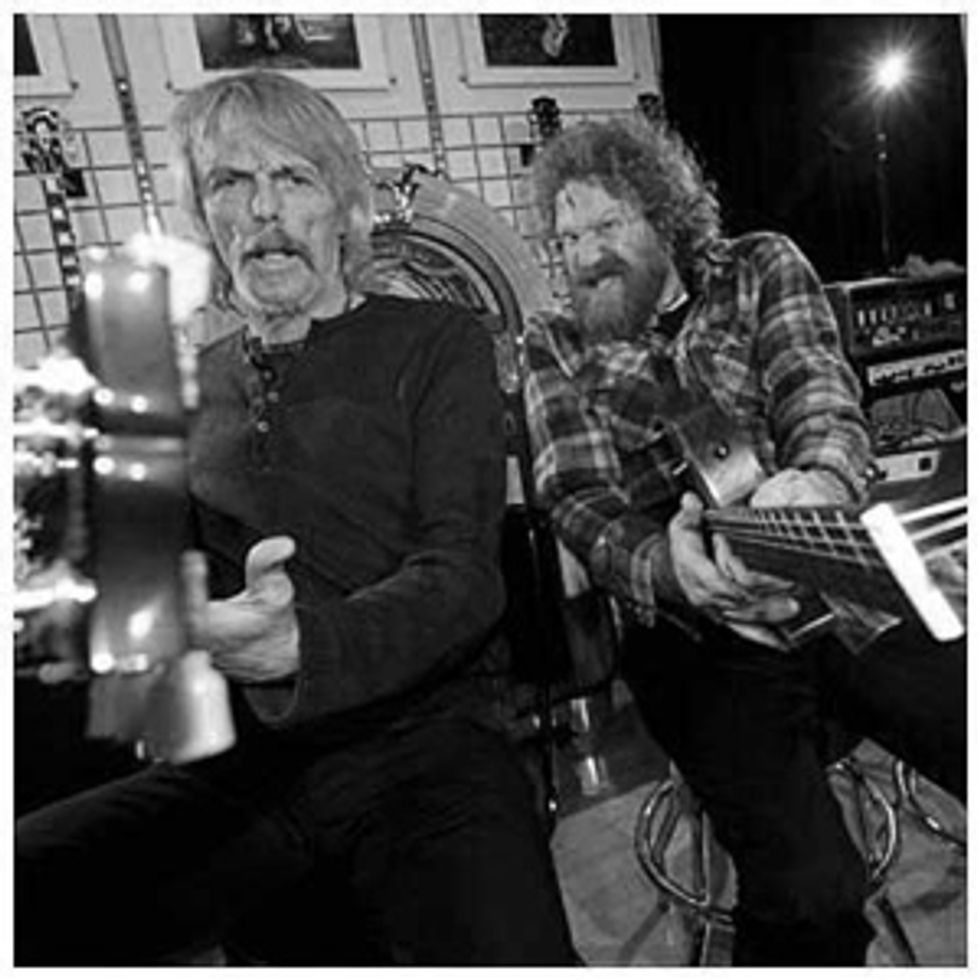 Scott Gorham (left) with Brent Hinds (right) |
BK: I personally have been a big fan of harmonizing guitars. The Fucking Champs, Metallica, Thin Lizzy and Boston are some of my favorite bands and they often have those harmonized, layered guitars that obviously have played a big part of what I like and play now. I’m always trying to come up with something to compliment the main riff, run or flow of the song. That kind of stuff usually comes out in rehearsal when I have time to sit there and play it over and over. That allows me to dial in my technique and get each note and riff the way it needs to be for the recording and sometimes I’ll even try putting down three different guitars for a part of a track just to make it super harmonized.
BH: It goes back to that Thin Lizzy reference and all those dual-guitar attack bands like the Allman Brothers and whoever else, it’s almost a necessity to double the guitar tracks to make them thick and something you can chew on. I know Bill almost always doubles his parts and everything I do I usually play two of them.
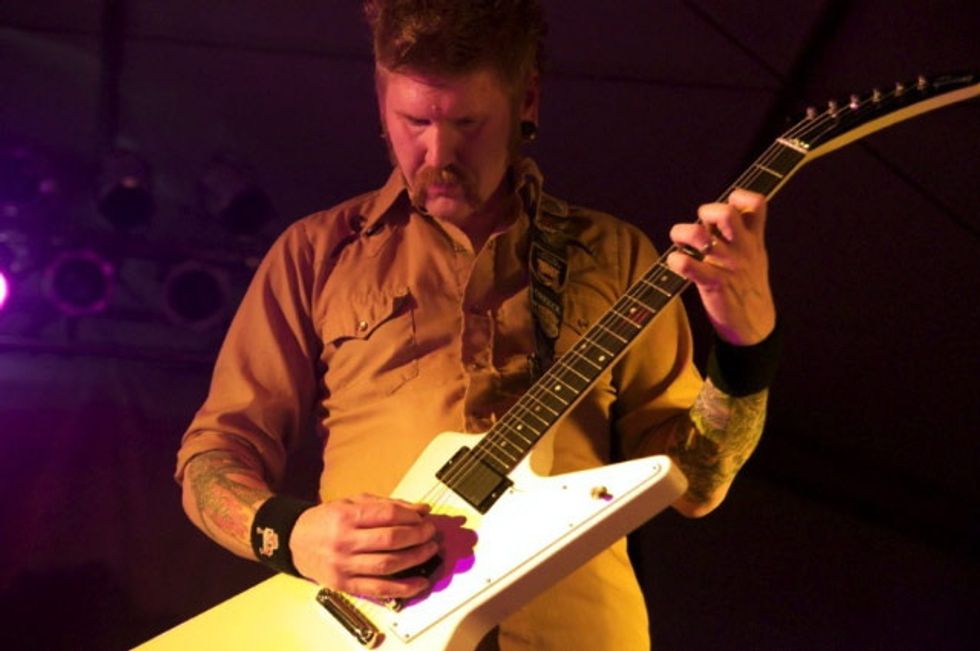
Do you guys layer all your guitar tracks or just portions?
BK: Usually for the meat and potatoes of a song—the heavy riffs—I usually only use one or two guitars because you don’t want to muddy the tracks with too much guitar. I mean, it’s good to have harmonized, layered guitars, but you don’t want it so much that you can’t hear each note or it becomes ridiculously sloppy sounding. Saying Brent and I are playing a riff—I like to double his part and then I add my own harmony on top of it because that way my two guitars are playing the harmony perfectly. If I’m playing against him, we never play exactly the same because of our styles and natural timing. If he’s got the main the riff and I play exactly what he’s playing and then I add a harmony on top of everything, at least my one of the guitars will lock up.
BH: For the solos, I usually just run through it and listen to what I cut and either start over fresh or if I’m happy with it I’ll pick a few spots and double it to bring some craziness in the mix.
So, let’s talk gear. In reference to the work done on Crack the Skye, did you use any new gear or gear provided by O’Brien?
BH: Oh man, he’s got so much gear. It’s all that old, vintage stuff from the ‘60s and ‘70s—none of that re-issue bullshit—and we just loaded up a truck of what we liked and took it down to the studio. It was just was nice being able to have all sorts of gear at our fingertips to use. For example, we were working on the “Divinations” solo and it starts with this real, surfabilly riff on one string [mimics the guitar sound] and we just wanted to exploit that surf-rock vibe so I busted out a red ‘64 Strat and played the solo through an original purple ‘68 Marshall JMP100 watt head. It sounds great and was exactly what that song needed. And “Quintessence” features Troy Sanders [Mastodon’s bassist] using a ‘79 Moog Taurus analog snyth that we bought before recording. I also play banjo on that same song, so it makes for some interesting tones.
BK: Yeah, he’s got gear to die for! I fooled around with a guitar you will probably never see me play live, which was an old yellow Telecaster with a Bigsby. I also fooled around with his JCM800 Lead Series 100-watt head (original)… those things are heavy metal.
Did you record with your own amps and guitars too?
BH: Of course, I used my ’72 Silverface Fender Twin Reverb head through a 2x15 Silverface cabinet. These bad boys offer me the ability to get some good crystal, clean tones which are a lot more evident on this record. And of course, I used my two different Marshall heads through 4x12 stacks with Celestion speakers (‘78 JMP Mark II Lead Series 100-watt & JMP2203 100-watt) for the more gritty parts. For guitars, I used my ’79 Silverburst Gibson Flying V and other Vs, Les Paul Gold Top, Martin D-15 and my First Act custom guitars.
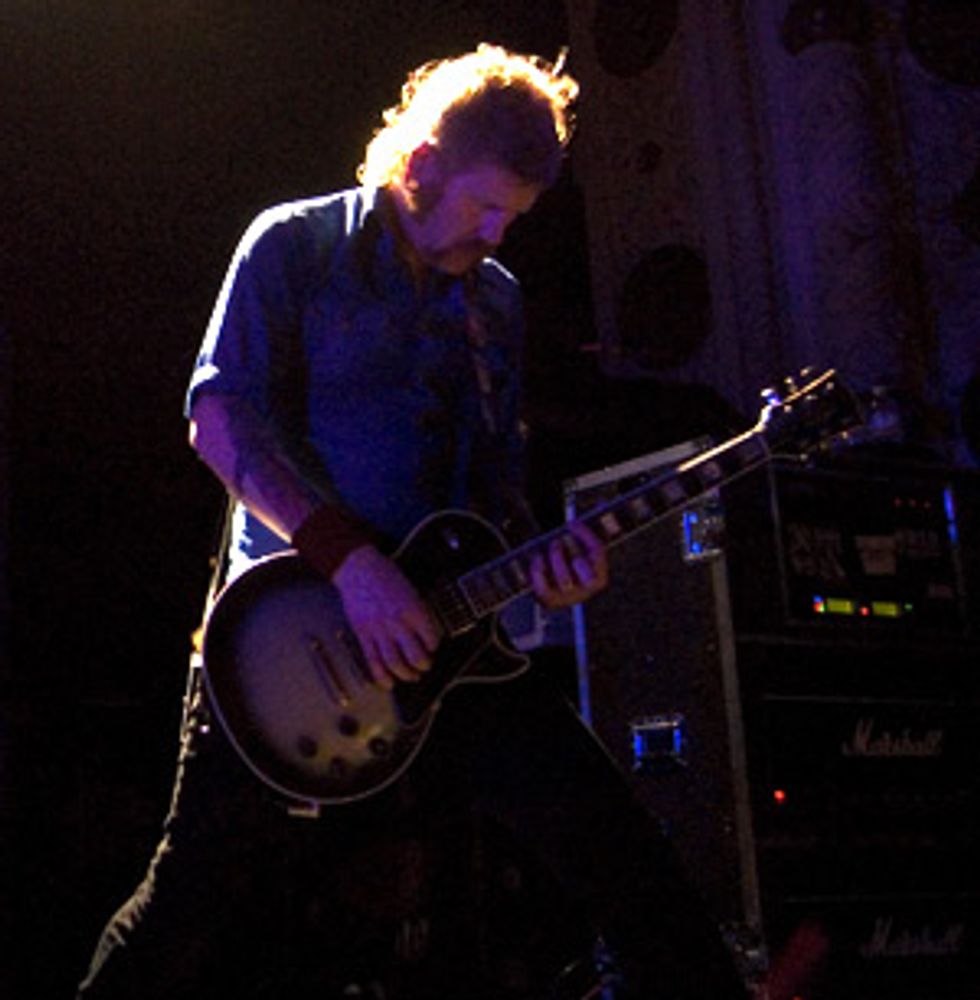 Bill Kelliher playing his Silverburst LP at The Metro, Chicago, IL 4/20/09 Photo: Trisha Feldman |
I’ve been using Marshall cabinets for awhile, but I’ve started using Mills Acoustics Afterburner 412B cabs with my Marshalls. Those Mills cabs are big, beefy, burly sound machines that just rock with four Celestion Vintage 30s. They sound great with the Marshalls.
Bill, you tend do a lot of rearranging with your signal chain, at least with amps and cabs. What was behind switching from using the Laney VH100R head to the Marshalls?
BK: Laney wanted to endorse me and they gave me some stuff to try out. At the time I was using my old Marshall JCM800 dual-channel amp and it sounded great in the Overdrive channel, but the clean channel wasn’t really there. As we started doing more and more clean stuff on our albums, I needed an amp that could go from in-your-face gritty crunch to crystal clean in a second, so I tried out some Laney VH100R heads. Those Laney heads sounded great, but I didn’t have a road-case for them and they got banged up a lot, so I haven’t plugged them in a while.
I just go through different moods with my amps. I stared with the Marshalls, switched to Laneys and then back to the Marshalls. I stay pretty stuck on my guitars, but I do a lot of rearranging with my amps and cabinets. I’m always looking for a new sound by using an old Marshall head through a brand new Mesa Boogie cabinet or a Mesa head through a Laney cab. I go through these weird phases where my ears change and I start to drift away from that sound and want to try something new.
You both are known for playing Silverbursts—what drew you to these guitars?
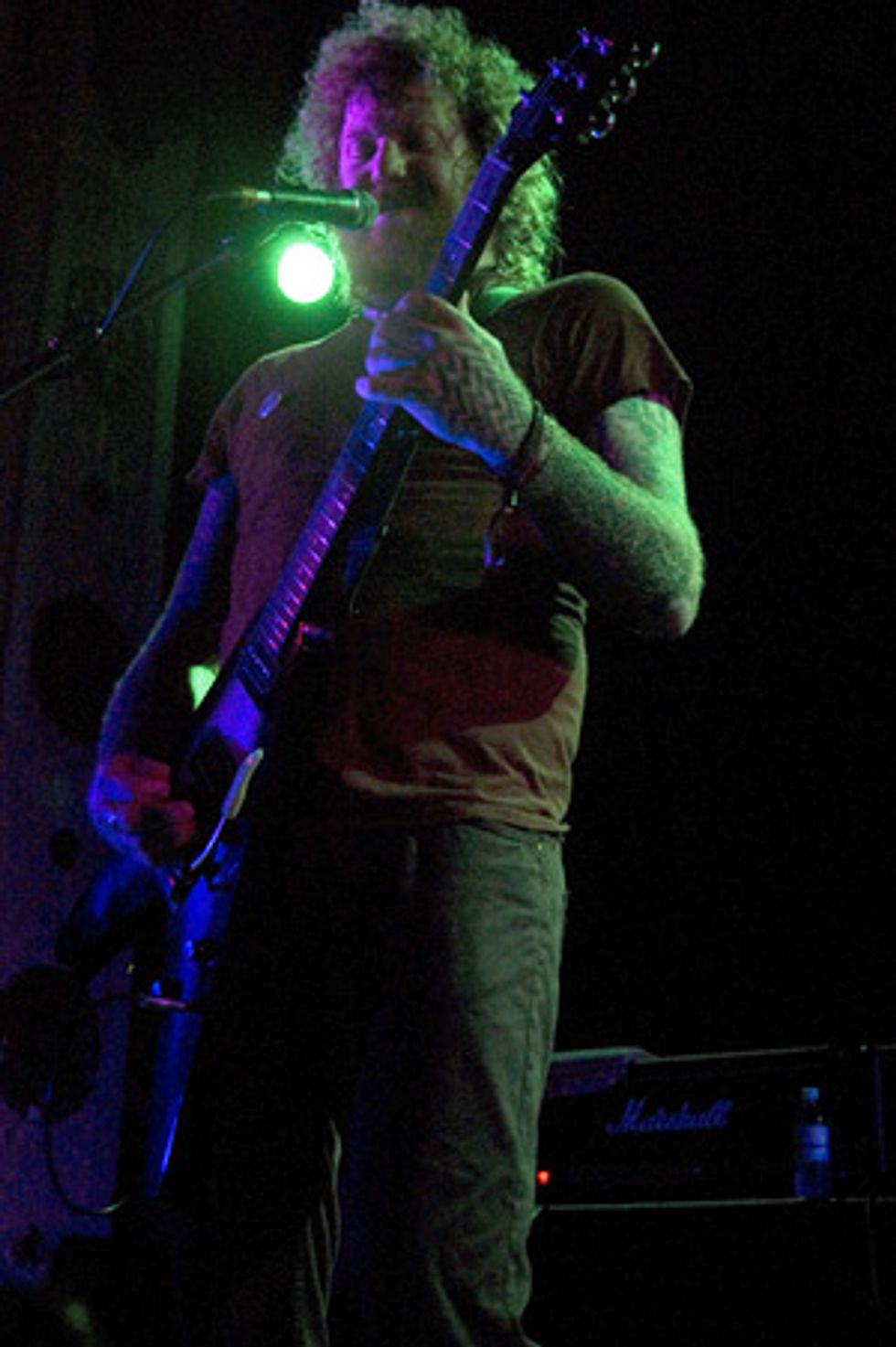 Brent Hinds playing his Silverburst V at The Metro, Chicago, IL 4/20/09 Photo: Trisha Feldman |
So, here I am, stuck with this broken Silverburst Flying V, but I fixed it up and actually used it as my main touring guitar. I’d have to say not many people use the Silverbust Flying V or at least tour with it as much as I did [initially, over five years] and I think that’s why it got stolen in Denmark with Bill’s Tobacco Burst Les Paul. After all that guitar and I had been through, I was kind of heartbroken because you can’t just replace a Silverbust Flying V since not a lot of them are made. So we went to a music store and I tried to find a replacement or something that would catch my eye and I found a Silverburst Les Paul Custom. It wasn’t a Flying V, but it was the closest I could find and right when I was going to get someone I saw Bill handing the dude a credit card for that same Silverbust Custom. So, there was a white Flying V and I stuck with those until I could find another Silverbust V. I finally just called Gibson and had them custom-build me a Silverburst Flying V.
The funny thing is that on the last tour we did in Europe with Slayer, after a gig in Denmark, some random dude gave me back my original ’79 Silverburst Flying V. He said he’d heard about my Silverburst being stolen a few years back and when he was at a vintage guitar convention in Denmark he saw it, bought it and held onto it for me until last year. That guitar shouldn’t be shaped like a ‘V,’ but a boomerang man! [laughs] I’m about to play it right now at practice [hits a chord].
BK: [laughs] Yeah, I guess I kind of stole Brent’s thunder with the Silverburst theme by snaking that guitar from him. I just like the way it looked and it just so happened to play like a dream.
Brent, it’s been know that you don’t use many pedals, tell me about the select few that are in your current arsenal.
BH: Generally, the only pedal I regularly use is this pedal my buddy John Spears [Monster Effects] made called the Mastortion. It pretty much has the power to blow a head right of my stacks, but that’s what I wanted. When it’s harnessed, that baby delivers… [laughs] He needs to build me another one, but he’s pretty elusive. The only other pedals I use are an Ibanez Tubescreamer TS-9, a Boss DD-6 Digital Delay, a Boss GE-7 Equalizer and a Boss TU-2 Tuner. That’s not to say I don’t add or drop a pedal here and there, but for the most part, I’m pretty minimal when it comes to the effects.
Anything other than those effects or something with a lot of knobs and switches [laughs], I don’t know how to work! I want to be like Omar Rodriquez-Lopez [guitarist of Mars Volta and At the Drive-In] with tons of effects and pedals, but I don’t have the most patience in the world and I only have one foot to control my pedalboard.
What about you Bill? How do you avoid bringing a pedalboard the size of a Mack truck?
BK: I think the key for us is that we limit ourselves to the pedals and tone-tools we use in the studio when recording to something that can be easily translated and emulated when we go on tour. For this upcoming tour we added a keyboardist who will hopefully be able to mix all those effects, atmospheric sounds, in addition to throwing down some mean keys.
But for my board, I mainly just use an Ibanez Tube King overdrive pedal, a Boss RT-20 Rotary Sound Processor that emulates rotary speaker sounds for some clean stuff, a MXR M-135 Smart Noise Gate and a Digitech JamMan Looper.
On your Gibsons, do you stick with the stock humbuckers or do you guys drop in something else?
BH: It’s the same deal as with effects man, I don’t like getting too complicated or messing with something that works. I can’t even tell you what pickups I play… whatever happens to be in the guitar when I plug it in. I’m just technology-challenged.
BK: I’ve been dropping the Seymour Duncan Distortion pickups (SH-6) in my guitars for years, but I recently tried out some of the new EMG X Series pickups (85/60) in my white Explorer and it shreds with some killer-crunching tones. I’ve been so used to the Seymour Duncans and know what to expect from those Distortion pickups, but then again, I’m always experimenting with things.
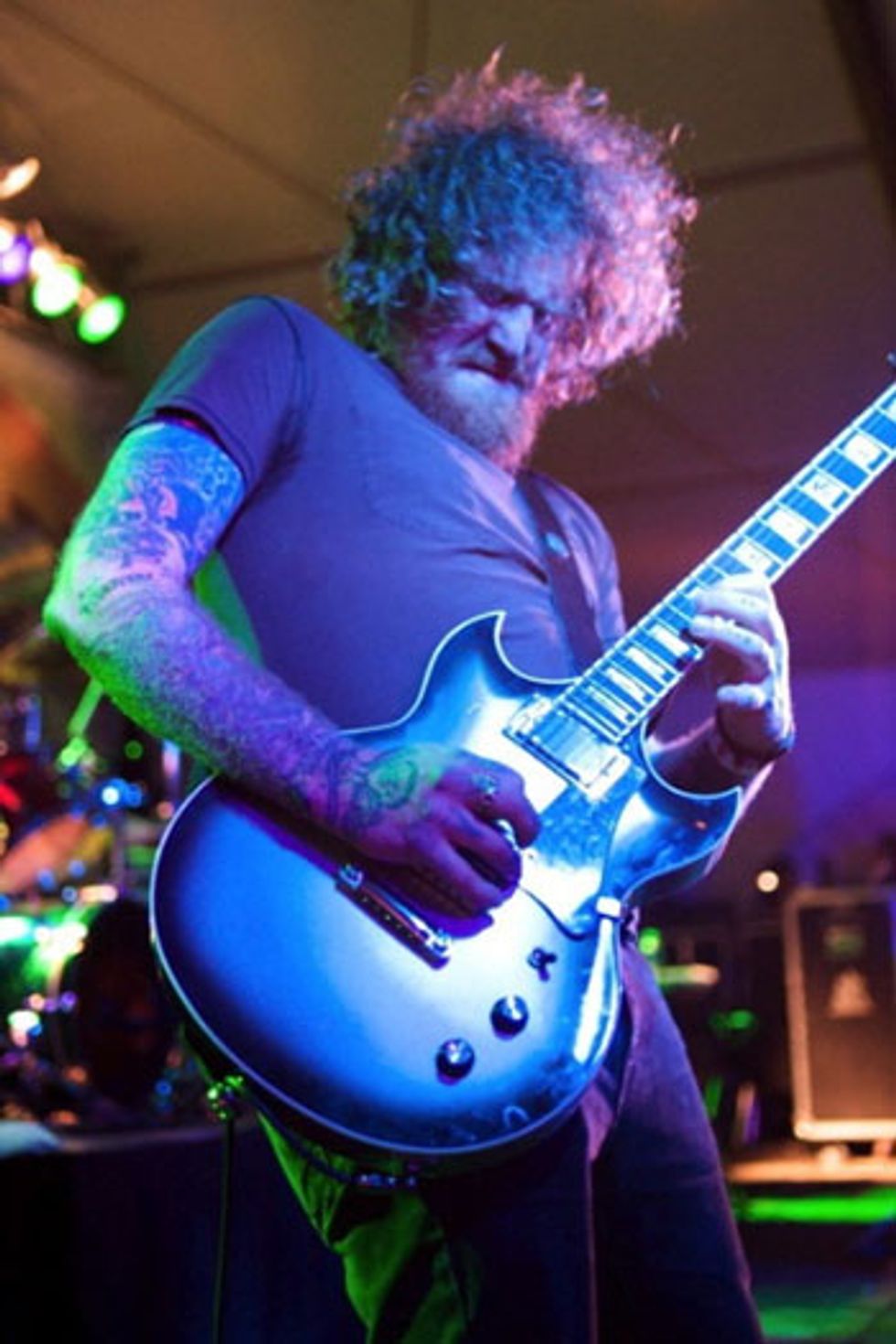 Brent Hinds and his First Act 12-string Photo: Andrew Stuart - FutureGrandpa.com |
BK: Its a great guitar. I actually use it quite a bit in the studio, particularly on the title track “Crack the Skye,” but I haven’t mastered all of our songs on it live yet. I might bring it out on this tour and bang on it for a few tracks. I’ve yet to see how road-worthy it is, so the Crack the Skye tour might be the perfect testing arena.
BH: I love ‘em man. They are probably some of the best guitars I own. And I’m not a guy that says that and keeps them in a closet. If you come to one of our shows, more than likely, you’ll catch me rocking out with a First Act. I mean, the guys at the Gibson Custom shop are the ones building those for the custom orders, so you really can’t go wrong there with their quality and attention to detail. However, I will admit, on both my 12-string First Act guitars and others owned by friends have had the neck pickup fall out. So I don’t know what that’s all about, but we just tape it in there and it sounds killer. Who knows, maybe the tape gives it some enhanced tone.
Brent, you’ve been known to play banjo, its even featured a few times on Crack the Skye, how has that helped your guitar playing hybrid-picking abilities?
BH: My family is deeply rooted in country and bluegrass, so I first learned how to play the banjo, then my dad bought me my first guitar and I studied music too [Alabama School of Fine Arts]. So I mean, since I learned the banjo first and studied music, there’s going to be an indirect influence on my guitar playing with banjo-type fingerings, but its nothing I specifically set out to do. I guess my dad knew what he was doing by giving me the banjo first.
Anymore, I don’t really even practice the guitar; I play the guitar. When I’m not jamming or touring with Mastodon, I’m playing with a lot of other bands that are completely different from each other. I’ll play guitar pretty much for any style of music; I just love it.
Brent, tell me about your other bands and what styles of music they play.
BH: Let’s see, Fiend Without A Face [also features Mastodon’s drummer Brann Dailor] is fun because it’s a combination of old surf-rock, psychobilly and bluegrass, which are all types of music I love. So, why not jam them all at once? Another band I play guitar for is The Blood Vessels, which has more of a classic rock vibe, kind of like Thin Lizzy with similar arrangements, guitar parts and lyrics. Then there’s this other band called the West End Motel, which is an acoustic country band. It’s just me on guitar and singing and another guy [Tom Cheshire] who is just singing. The music is in the vein of broken-hearted country songs like Hank Williams, Buck Owens and Gram Parsons. Another country-esque band is the Blue Eyed Devils which I play acoustic and electric guitar and we also feature a guy on a steel pedal guitar and banjo, a stand-up bassist, mandolin player, drummer and two lead singers [a woman and man]. And when I do have a free night or weekend, I’ll always just pop in local studios or gigs and just jam. I guess I’m just the local musician-dude that anyone will call up because they know I’ll play if I got the time. I just truly enjoy playing; it’s what gets me up in the morning.
Well it seems you might not “practice” much, but you definitely play a lot.
BH: For me, I get so much more out of just playing all types of live music with people than sitting down and playing by myself. That’s how I get better. I don’t say I’m just going to play metal or rock. For instance, a few of our riffs on the new album are chicken-pickin’ [see “Divinations” intro] or surf-style rock. However, that’s not to say sometimes I don’t sit up until all hours seeing how fast I can go or noodle on some solo bouncing around in my head. But for the most part, I just play with whoever, whenever.
Guitarists, like most inventors, tend to come up with ideas during inopportune times, what do you guys do to retain any riff ideas?
BK: I just play guitar as much as I can and anytime I think of something that sounds cool I’ll either record it onto my Pro Tools rig or even hum a lick into my phone and revisit it later. I just try to build up a collection of riffs and ideas and then go through it later. It’s funny, a lot of times, the stuff I thought was hot or cool at the time, when revisited, sounds like shit, but it often creates new, better ideas for riffs. So, I tend to even keep the bad ideas because if nothing else, they’ll turn into good ones eventually… or so I think! But what I think it comes down to is that we just have a lot of music in us, its just sifting through the “riff-pile” and finding what is “Mastodon.”
BH: Well, since I’m always playing somewhere, with someone, hopefully I catch the idea while its still hot and play it. Also, I keep a guitar at my bedside so when I can’t sleep or wake up with a killer idea I can play it out right there in bed. I don’t really ever record or write anything down in a book. I figure if I can’t remember the riff, it’s probably not worth remembering or good enough to play.
Bill, while Brent takes a lot of the leads, your rhythm playing often carries the force of the song. What do you attribute that to?
BK: I’ve always played rhythm a lot in previous bands. I played in a lot of three-piece bands where I had to play the solos and leads, but at the same time carry the bulk of the song. When I was a kid I played along with albums and just used it as a modern-day Pro Tools or other computer software by following the drums and bass. Obviously, back then, I was unable to do any of the solos, so I just focused on locking in on the rhythm.
I’m just trying to keep up, especially playing with Brann since he’s all over the place sometimes—he doesn’t even play the beat. He just goes off and plays the same exact notes as I am and on top of it, he’s playing a million miles a second at certain points so it forces you to be on your game. I’ve been playing for so long, so hopefully it shows a little.
Brent, how does Bill’s solid rhythm playing help your own guitar playing, especially the solos and overall development of the guitar parts in Mastodon’s songs?
| ||||||||
| ||||||||
| ||||||||
| mastodonrocks.com |
Bill, seeing Mastodon as kind of a chameleon band, how does the variety of styles and genres the band has fit into affect your set lists or adjust the way you guys perform?
BK: If we’re doing a tour with Slayer, we’re definitely not going to play a 20-minute song like “Hearts Alive” because we know the crowd wants to hear fast and heavy. So, we’ll hit the “fast-and-heavy-Mastodon switch” and give them what they want. But if we’re on tour with a band like Isis or Clutch, with a following that is more accessible to something more than the fast and hard shit, we’ll play around with the set and do some experimenting with songs and arrangements. [laughs] If nothing else, in a setting like that, we can just play three 20-minute songs and be done! Playing with bands like Isis or Neurosis, you have a little more freedom to do something off the cuff or alternative, but when you’re with Slayer and their legions of fans you want to come out swinging; you don’t want to give the kids any reason to boo or throw shit at you. I’ve seen it happen to really good, talented bands when faced by the Slayer army.
With your upcoming summer European tour opening for Metallica, how do you guys feel when people suggest this pairing as a kind of passing of the torch from the band that forged the heavy metal genre in the ‘80s, to you guys, who have helped reinvigorated it?
BK: It’s quite an honor. It’s pretty fucking cool because when I was a kid first putting on a guitar I wanted to emulate them. I had the jean jacket with patches, ripped jeans and I tried learning all their famous licks. It’s rewarding to have people lump us with an act like Metallica and their lineage of classic albums. I guess all this hard work on practicing guitar for hours and hours finally paid off when you put it like that.
BH: Shit man, that’s cool with me… [laughs] because we all listened to those albums when we were growing up, so to have our name and albums thrown in with those guys, come on, who isn’t going to like that?! It’s not something we set out to achieve by saying “Crack the Skye has to our Master of Puppets,” but we definitely wanted to make a statement of the roads we’ve traveled, the ups and downs and who we are as a band today. And we think we achieve that with this album.
Photos: Andrew Stuart - www.FutureGrandpa.com



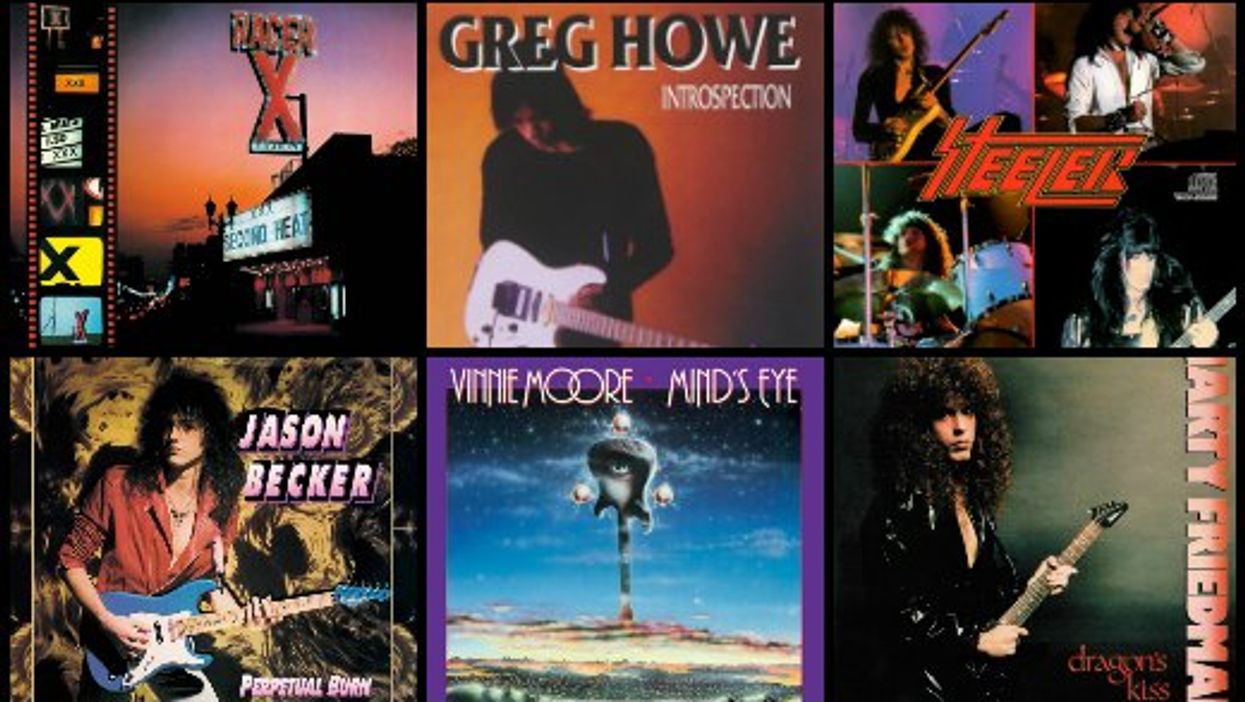
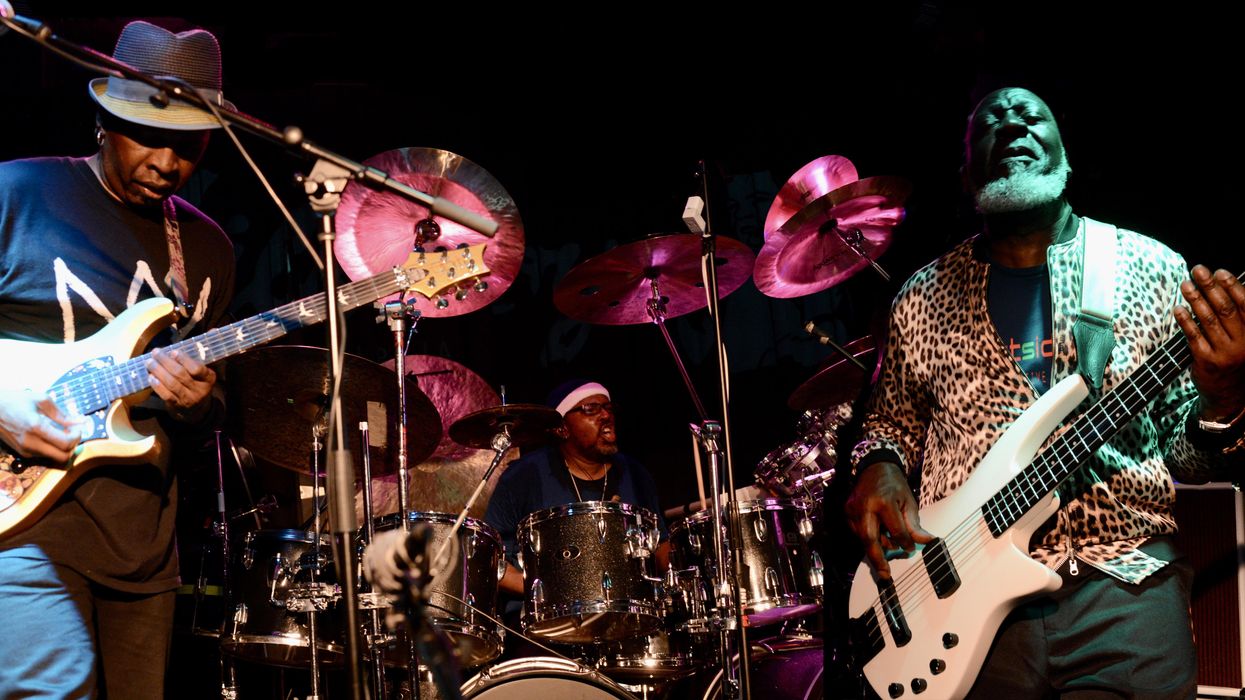









![Rig Rundown: Russian Circles’ Mike Sullivan [2025]](https://www.premierguitar.com/media-library/youtube.jpg?id=62303631&width=1245&height=700&quality=70&coordinates=0%2C0%2C0%2C0)
















![Rig Rundown: AFI [2025]](https://www.premierguitar.com/media-library/youtube.jpg?id=62064741&width=1245&height=700&quality=70&coordinates=0%2C0%2C0%2C0)




















 Zach loves his Sovtek Mig 60 head, which he plays through a cab he built himself at a pipe-organ shop in Denver. Every glue joint is lined with thin leather for maximum air tightness, and it’s stocked with Celestion G12M Greenback speakers.
Zach loves his Sovtek Mig 60 head, which he plays through a cab he built himself at a pipe-organ shop in Denver. Every glue joint is lined with thin leather for maximum air tightness, and it’s stocked with Celestion G12M Greenback speakers.






